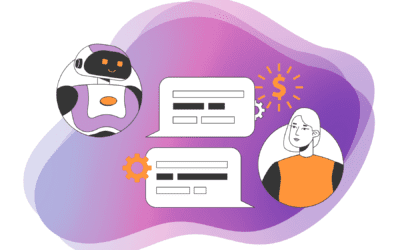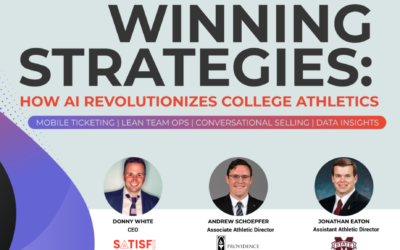The pandemic has accelerated the shift to digital communication and mobile engagement. College athletics programs, professional sports teams, and venues are adopting conversational technology to supplement staff, influence purchase decisions, and collect unique fan preference data.
In a recent webinar, Mike Castle of Georgia Tech, Penn State’s Rob Kristiniak, and Genette Sekse Amar of the Minnesota Vikings joined Satisfi Labs’ Don White to discuss their experiences implementing tech-centric touchpoints and why these changes are no longer considered an innovation strategy but part of an essential operational strategy.
On what’s new about this year and what is being done to prepare for this season considering the uncertainties. (03:20)
Mike: “One thing to consider is what’s new is new for the majority of fans. We’ve been through a year of social distancing and adaptive policies for Covid. A lot of our fans either took the year off on their own or because of capacity limits weren’t permitted to come to games. So we have to keep in mind that there are two types of fans we’re servicing this year — the folks that were in the environment of a limited capacity last year, which was kind of an odd year with some of the things going on and the fans who took the whole year off. So for us, it’s been the preparation of not missing communication to both of those groups. We want the people that came last year to stay engaged but to realize that — that was a unique year and that we’re moving back to as close to normal as we can. For the fans who took a year off, either by choice or because of capacity limits, we want to make sure that they feel engaged and that we educate them on some of the permanent changes, like mobile ticketing which is here to stay in our venue. We have this confidence after going through it for a year and our fans successfully getting the hang of it by the end of the season, but there’s a whole new group that hasn’t experienced that yet in our venue. We have to keep in mind that we’re going to be communicating with two different types of fans that we’re going to be reengaging at games this year.”
On what technology is being looked at this season to deploy to their new fan base that’s returning this year. (12:40)
Rob: “Some of it starts with understanding the existing data that we already have. We have to be more conscious of how we’re using that to our advantage. Working with Satisfi is about the education piece we get. I’m on a lot of sales calls as we’re trying to place people with season tickets before the season starts and it’s clear that fans are going to the wrong place. Or better said, they’re getting information from the wrong spot by using search engines and it’s our job to get them to the right spot. I view this technology as a tool to get us into a holistic approach on our game day. Where you park, how do you get to the game, where is the best stand to get pizza. Our focus is on how we educate people on that in advance because connectivity in our venue is an issue. How do we make sure all of that is done before they get there or provide that resource for them. The things we track like the number of labor hours we’re saving from using our chatbot, based on the number of questions that are asked on a monthly basis and the number of unique visitors we’re helping. Those are key takeaways and we’re answering a lot of questions that aren’t making their way to our phone lines. The immediateness of that instant gratification that everyone expects to get, we’re trying to help that a little bit.”
On how was it getting fans adapted to mobile ticketing prior to the pandemic when it became a necessary thing. (17:20)
Genette: “Looking back, everyone was really scared to adopt mobile ticketing and we were terrified. Especially those people in our ticket office who had been around for 25 years, they said there was no way it would work. But we were moving into a new stadium and we needed to know who was seating in our seats. With physical tickets, they were getting passed around a lot. It was shocking because in some instances we saw tickets being passed between fans maybe 50 or 60 times. With mobile tickets, we can actually see who these people are and capture information about people who actually want to come to our games. We knew who the last person sitting in each seat was. We ran promotions and we added Satisfi to this process to walk them step by step on how to get in. It was critical because people were asking a lot of questions. People think we have a lot of resources because we’re in the NFL, but we have 5 people in our ticketing office. They’re selling and they’re also dealing with our customers. That’s a lot when you have 66,000 fans coming on a game day and transferring tickets. It was forced, but people adopted it pretty easily. And we’re seeing now how much it has grown. We had 99% digital ticketing in 2019 and we’re giving our fans a lot more technology to interact with when they’re at games. It’s not just mobile ticketing, everything now is in their hands, in their phone. They interact with us in so many ways, whether that’s mobile ticketing, chatting with us, watching replays on their phone. Whatever they wanted to do, we wanted to make sure they had more advantages.”
On what the data can tell you about your fan’s overall game-day experience. (33:45)
Genette: “When we surveyed our fans that were using the chatbot versus those who weren’t, we discovered that fans who interacted with it got their answers right away and knew what they were looking for. They rated our game day experience by 1 percentage point which is where we are of value in the NFL. So we knew that if we got them to use the chatbot right away in our journey, then they’d be interacting with us throughout their entire game day. Any question they had would be answered within seconds and if not, then they’re talking to a live person. One whole percentage point is a huge jump from a fan experience standpoint when you’re trying to talk to your customers in that way.”
On how to work with your development team fundraisers to ensure a next-level approach for engaging and stewarding your donor base. (40:15)
Rob: “That’s another extension that we can start exploring further. If you ask a question about a donation or gift then it immediately pops up and lets us know that you want to support the Nittany Lion Club. Click here, make a gift and it immediately takes you to the page to purchase. But I do think there are areas in which we can get more thorough. For instance, if you want to make a major gift or you want to do something specific, there are avenues we haven’t yet tapped there. That’s the cool thing here, we’re finding out new stuff every day in terms of how this isn’t just a sales or service assistant, but an overall experience thing from many different avenues.”
On what to look for when on-boarding technology companies and getting it approved in the budget. (46:00)
Mike: “A lot of people will look at the names of our schools and think well they can afford it because they have a big budget, well we don’t have a giant budget either. I think the first question your boss will ask is what’s the ROI. Then you have to think about all the tangibles you can directly connect to an ROI, but there are actually things you can connect to direct revenue. The number one clicked thing in our chat is ticket information. It gives us leads; it gives us people to follow up with that we can close sales with. But there’s also sponsorship revenue that can be driven. If you can present something to a boss that’s going to be paid for right off the top with potential for sponsorship, and then everything else is just butter on top of that in terms of ROI, that’s a real plus. Before you can go with an idea you have to be able to sell the ROI and present more than just what they’ll think are just bells and whistles. If you can present a strong case for an ROI, then it’s going to be a no-brainer for introducing new technology.”




